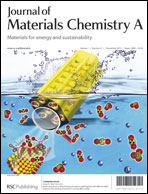Using POSS reagents to reduce hydrophobic character in polypropylene nanocomposites†
Abstract
Three POSS reagents (1,2-propanediolisobutyl POSS, glycidylisooctyl POSS, and triglycidylisobutyl POSS, all 5 wt%) are incorporated into a commercial isotactic polypropylene, PP. Infrared and Raman spectroscopy show that the blending has been successful as evidenced by the presence of Si–O–Si bands at 1098–1110 cm−1, which are not present in the base polymer. The inclusion of 5 wt% of the various POSS reagents leads to a general increase in the loss modulus at the Tg (e.g. the greatest increase being from ca. 125 MPa to ca. 150 MPa) from DMTA data, although the Tg of the PP is slightly diminished by 4–8 K depending on the POSS used. The melting behaviour is also altered as the addition of POSS leads to a more diffuse and multimodal melting endotherm in the blends, although the melting temperature does increase slightly (7 K). TGA data confirm that the thermal and thermo-oxidative stability of PP is not adversely affected by the inclusion of the POSS reagents at this concentration. Tensile data show that the ultimate tensile strength (ca. 24.7 ± 0.1 MPa) remains the same, although the tensile modulus (ca. 1.24 ± 0.06 GPa) is reduced by up to 0.22 GPa and the maximum load does reduce by ca. 80–160 N. Contact angle measurements for the PP (99.72° ± 0.73) show that the inclusion of the POSS reagents at this level does reduce its hydrophobic character as the greatest depression in contact angle is effected by the inclusion of 5 wt% triglycidylisobutyl-POSS (85.77° ± 1.39). Molecular modelling and QSPR techniques are used to predict selected physical properties of the PP/POSS nanocomposites.


 Please wait while we load your content...
Please wait while we load your content...